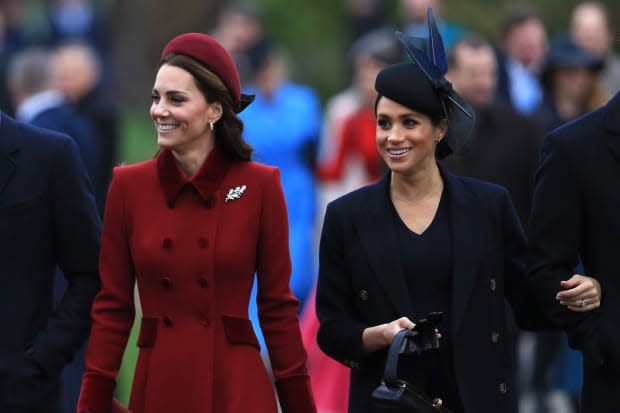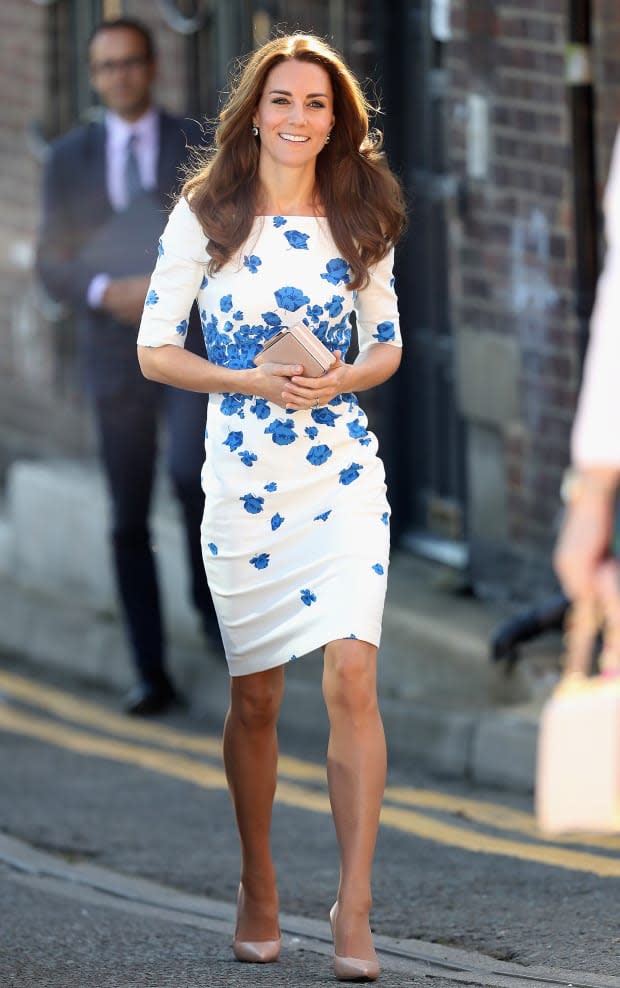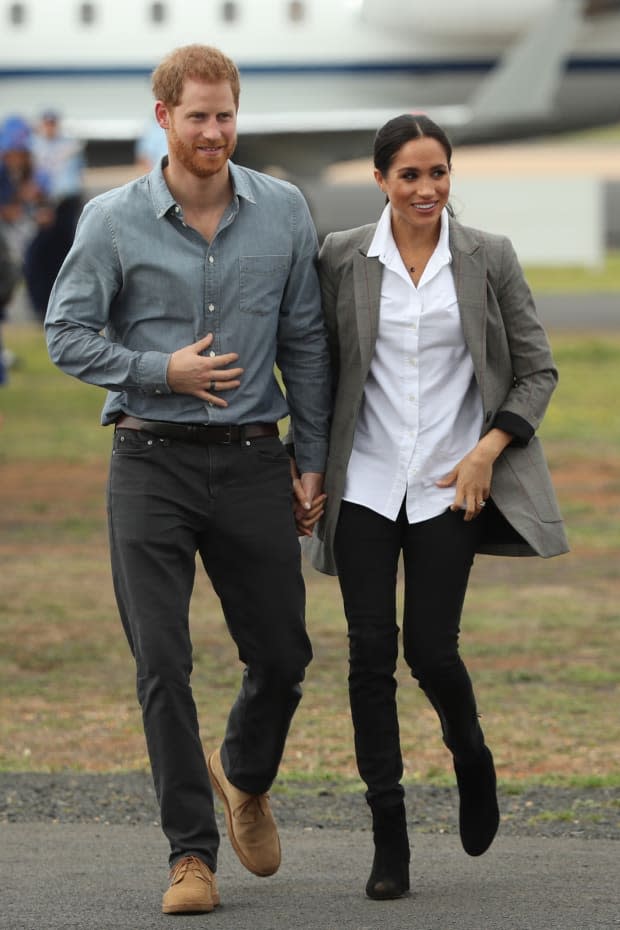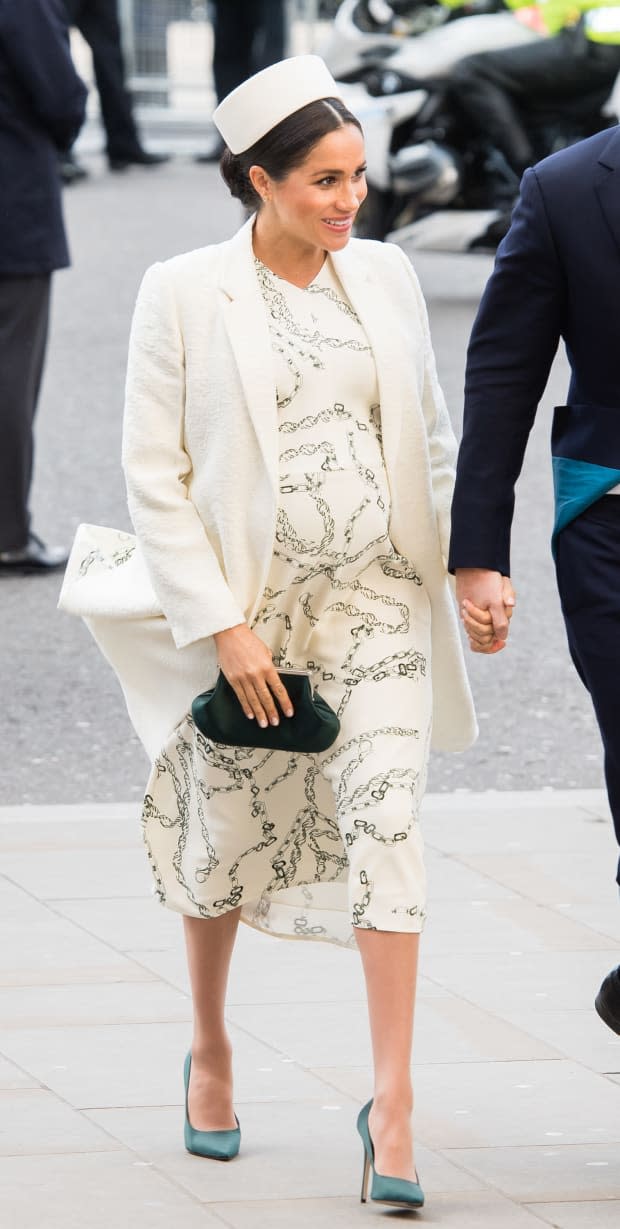Royally-Beloved Brands Can't Rely on the 'Meghan Markle Effect' Forever
As labels once boosted by Kate Middleton have learned, it's what comes after the royal exposure that matters most.

"Look at what I just bought." My friend whips out a pair of Le Specs sunglasses. It's the $70 Air Heart style in black — the exact same ones that Meghan Markle was snapped wearing in New York City last month. "I'm not this person," she says, defensively. "I usually never buy anything that a celebrity wears." But it was a classic, seasonless pair of cat-eyes, it was exaggerated just enough for a modern statement and the price point was reasonable.
That's just one example of how rampant the "Markle Sparkle" is, even two years after it was first announced that she was romantically linked to Prince Harry and nearly a year after her wedding.
There's still an immense response to the brands she's been known to favor, like Veja, the transparent sneaker company that upcycles plastic bottles, or Outland Denim jeans, which the Duchess of Sussex wore on more than one occasion during her tour of Australia, New Zealand, Fiji and the Kingdom of Tonga in the fall of 2018. A paragon of moral goodness and sustainable fashion, the denim brand employs women who are rescued from human trafficking and sexual exploitation.
"With Meghan, a lot of new brands have come on my radar that I had never heard of before — and it's these brands that people are responding to," says Elizabeth Holmes, style reporter, royal enthusiast and founder of the Instagram sensation So Many Thoughts.
For Outland, the effect was immediate. The brand's founder James Bartle says that it saw a 3,000 percent increase in traffic to its Australian site, a 948 percent increase to its international sites and a 640 percent increase in sales the week of Markle's appearance (the black Harriet jeans that she wore sold out in Australia in the first 24 hours, with a waitlist for new inventory in April).
"You cannot put a price on the brand recognition nor the credibility that the Duchess is able to bestow on a small, socially oriented enterprise such as ours," Bartle says. "Consumers the world over discovered our brand by virtue of the Duchess wearing the jeans, and she paved the way for us to tell our brand story on multiple media platforms globally."

In fact, Marshal Cohen, the chief industry advisor of market research company NPD, says 61 percent of consumers reportedly prefer to buy items that they have discovered. Perhaps this is one reason why LK Bennett is now struggling to stay afloat, despite being one of Kate Middleton's favorite brands.
Royal enthusiasts can readily call to mind iconic Middleton looks that came courtesy of the high-street British label, but for the uninitiated, there was the unforgettable blue-and-white poppy-print Lasa dress that she wore in 2014 for a tour of the Royal Australian Air Force Base (and again in 2016 for a visit to Keech Hospice in Luton). She wore her reliable nude Sledge pumps consistently from 2011 to 2014. Even as recently as last December, her green polka-dot Mortimer shirt dress sold out almost instantly. And LK Bennett's been right there for notable, history-making moments, too, like when the Duchess of Cambridge welcomed Barack and Michelle Obama to Kensington Palace in 2016 in a belted midi dress.
Middleton's steadfast dedication and unwavering loyalty to LK Bennett is one that most brands could only dream of having. Cohen calls the phenomenon of a celebrity's endorsement of a brand "catching lightning in a bottle."
"Whether it be by design or by accident, it's really hard to come by — it might not ever happen again," he explains. "When it does happen, you have to take advantage of it, you've got to build the foundation that will last when the lightning storm subsides."
While LK Bennett's steady, longtime relationship with Kate Middleton may be something that's sought after, it's the lack of discovery, the predictability that might have also turned consumers off from the brand. LK Bennett reported a 5.9 million-pound loss in the 2018 fiscal year. Ten years previously, its founder Linda Bennett relinquished a controlling stake in her company in a 100 million-pound deal with Phoenix Equity Partners, but after years of troubles, she bought back 45 percent in 2017. Now, with 500 jobs at stake and about 200 brick-and-mortar locations worldwide, the brand brought in advisors for a potential sell. (A request to LK Bennett for a comment was never returned.)
"The royal power is in the exposure, and I wonder, once the royal wears a brand repeatedly, if that exposure gets watered down," Holmes says. "It's exciting when Kate or Meghan step out in a new brand and everyone goes nuts and their website crashes, but if it becomes a commonplace thing, like Kate wearing LK Bennett, the effect on that brand isn’t as powerful each time."
The price point, too, may be a contributing factor. With dresses that can run up to $645 and heels that average at $300, LK Bennett designs aren't exactly the most affordable nor are they considered luxury investment-worthy pieces. For Holmes, the more accessibly priced a dress or a shoe or a bag is, the more of a frenzy it stirs up among her followers. Navigating the retail landscape is tough enough as it is, but this contemporary space is especially challenging.
And in this digital age, with the number of fledgling start-ups flooding social media, Cohen says the pace at which a brand rises — and declines — has accelerated.
"There's no question that social media has made obsolescence much quicker; consumers want innovative designs from new brands — they don't want repeat products anymore," Cohen says. "Brands need to build stability and be ready for when the celebrity is no longer in the same limelight or the brand's recognition becomes old and stale. So what are you doing to make your brand to remain relevant?"

For an ill-fated brand, Cohen's prescription is to pivot and build an identity that goes beyond simply selling clothes. Case in point: Outland Denim. Bartle admits that sales have tapered since the first Markle appearance, but every aspect of its business continues to grow: pre-order sales, social media, wholesale outreach, new product offerings and a new state-of-the-art facility in Cambodia. Most importantly, the exposure has led Outland to sign on 46 new staff members. (The label was also recently recognized by Common Objective as a leader in sustainable fashion in 2019.)
"We've worked hard to carve out a brand identity that is really three dimensional, in that there is real depth behind the work we do as a social-impact brand," he says. "Meghan has brought it to life; she embodies so much of what our brand stands for, from women's empowerment to concern for the vulnerable to sustainability."
Similarly, Bianca Gates, the co-founder of Birdies, feels that Markle perfectly represents the values of her footwear company, which not only bridges comfort and fashion with versatile slippers, but also aims to empower women — a message that Markle has promoted, inadvertently or not, simply by wearing her black slip-ons.
"Birdies stands for lifting other women up, and we're working hard on building that internally," Gates says. "Meghan is setting the tone of the brand and what we've always wanted to be, and she's helping to lead this message at a much larger scale."
Markle has worn Birdies since 2016 — before becoming a royal — and following each tagged post on Instagram, Gates says the brand saw an uptick in sales from her followers, but it pales in comparison to the surge they've seen from the two instances she's worn Birdies as a Duchess: 1) a walk through the redwoods in New Zealand following her pregnancy announcement and 2) during a visit to an all-girls boarding school in Morocco. The first time generated a 30,000-person waitlist; since then, Gates admits that it's become less of a surprise, but there's still major spike.
"How do we take advantage of these great moments? Ever since the first time she wore us, we have said that we need to build a brand that's bigger than any one person," Gates says. She is cautious of not getting swept up by the hype and scaling too fast, referencing Kate Middleton's royal blue engagement dress by Issa, a label that ultimately went bankrupt, as a deterrent example. "We have to be careful that we don't go crazy and grow too fast because of one moment in time, but rather grow because of a groundswell of love for the brand."
Some might make the argument LK Bennett's demise is indicative of a diminishing Kate Middleton Effect, especially with the arrival of Markle. But Holmes doesn't believe that's the case. "I think people's choices, trends and tastes have changed, and the economy has a big effect," she continues. "At the end of the day, a royal will not sustain a brand. A brand has to have a strong identity, strong values and a strong connection with its customers."
Markle's penchant for supporting under-the-radar brands versus falling back on repeat clothing from predictable labels certainly helps in fueling the Markle Sparkle. It's what those brands do next that's critical to their survival.
"The royals have the power to put a brand on the world by stage, but it's on that brand to convince shoppers why they should stick around," Holmes says. "Meghan has done a great job at wearing brands that promote a cause or support a bigger mission. It's harder for a brand that doesn't have that."
See things the Duchess of Sussex has worn in the gallery below:

Victoria Beckham Dress for Commonwealth Day. Photo: Samir Hussein/Getty Images
View the 105 images of this gallery on the original article